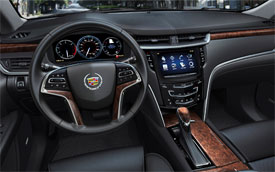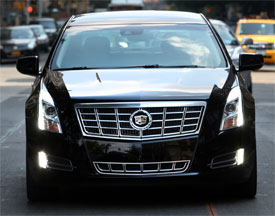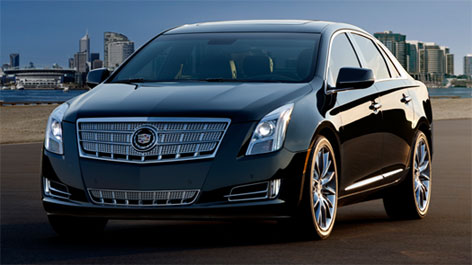2013 Cadillac XTS
Cadillac has made steady progress in transforming itself from a premium domestic brand to a global luxury car player. The sporty CTS and the SRX crossover can hold their own against all comers. But, now it’s time for Caddy to play with the big boys - the large luxury sedans that define truly great brands. In Cadillac’s corner, it’s the all new XTS. So, let the games begin.
The 2013 Cadillac XTS has a lot on its plate. It will carry the torch against leading-edge large luxury sedans like the Mercedes-Benz E-Class, Lexus GS, and Audi A6. But, it must also appeal to customers of the two cars it will replace, the full-size DTS and mid-size STS. That’s also probably why the XTS’s overall length of 202 inches is shorter than the DTS and longer than the STS. But, even as an in-betweener, it’s still longer than global rivals. Targeting V6 competitors, the XTS comes amply equipped with the CTS’s direct injection, 3.6-liter V6, though it puts out slightly less power here at 304-horsepower and 264 pound feet of torque. Like the GS the XTS connects with a 6-speed automatic transmission. The E-Class has 7-speeds and the A6 sports 8. But despite fewer gears, Government Fuel Economy Ratings are very respectable at 17-City and 28-Highway. And, unlike competitors, the XTS gets by fine on Regular gas.
Although oriented as a pure luxury car, that doesn’t mean the XTS rides like a floaty luxo-boat. Magnetic Ride Control with rear air springs is standard. Combined with the dual-path HiPer Strut front suspension, ride can be as firm or as soft as you want it to be. Plus, the optional Haldex all-wheel drive system with limited slip differential varies torque at each rear wheel for a further handling boost. However, the front or all-wheel-drive XTS is not a car that you can really push through the corners, but it is one that does feel smooth, comfortable, and very solid when driven at a spirited pace.
 To us, the high point of the XTS is the interior with a level of comfort and high-tech features that will surprise even the most ardent skeptics. Looking both elegant and futuristic, the multi-dimensional layout features attractive wood trim and plenty of tightly wrapped cowhide with exposed stitching. The XTS is also the launch vehicle for Cadillac’s new CUE interface. The Cadillac User Experience consists of an 8-inch center screen with the same captive touch technology used on tablets and smart phones, with the most natural voice recognition system we’ve yet tried. And speaking of tablets, all XTS’s will come with an iPad preloaded with a CUE app to help owners learn how to use it with minimum distraction.
To us, the high point of the XTS is the interior with a level of comfort and high-tech features that will surprise even the most ardent skeptics. Looking both elegant and futuristic, the multi-dimensional layout features attractive wood trim and plenty of tightly wrapped cowhide with exposed stitching. The XTS is also the launch vehicle for Cadillac’s new CUE interface. The Cadillac User Experience consists of an 8-inch center screen with the same captive touch technology used on tablets and smart phones, with the most natural voice recognition system we’ve yet tried. And speaking of tablets, all XTS’s will come with an iPad preloaded with a CUE app to help owners learn how to use it with minimum distraction.
The gauge cluster appears on a 12-inch screen of its own. There are multiple configurations, but if you find it distracting, the available Head-Up Display gives you plenty of info while letting you keep your eyes totally on the road. An 8-speaker Bose system with HD radio is standard, but you can upgrade to a full Studio Surround sound system with 14-speakers. Keeping up on the technology front, a whole raft of safety features are available, including the usual blind spot and lane departure warnings, but also automatic front and rear braking and a Safety Alert Seat that will vibrate to alert the driver of potential problems. When not vibrating, the front seats are incredibly comfortable, as you would expect in a Cadillac, and are covered in varying grades of leather, depending upon which trim level you choose. And not only can you fit 3 full-size adults in the back, all their luggage as well as the XTS’s trunk will swallow an enormous 18-cubic-feet of belongings with ease. And, in order to ease fueling, Cadillac has also added a capless fuel filler.
Though there are some remaining art and science sharp lines, the XTS has a much softer overall look than the CTS. The latest evolution is more polished, more mature, less intent on making a statement, and more focused on just being confidently luxurious. A large multi-dimensional grille is the centerpiece of a wide front end that includes standard HID headlights with adaptive lighting available.19-inch wheels are standard as well, 20’s optional and they underline a profile that is very smooth looking, if a bit chunky. There’s less departure from tradition in back, as tail fin tail lights and a large wreath and crest are proudly displayed. Dual exhaust cutouts are trimmed in chrome.
 When it comes time to visit your local Cadillac dealership, you’ll need to bring at least $44,995 for a Standard front-wheel-drive XTS, of which we doubt many will be sold. Most buyers will opt for either the Luxury or Premium Collection, while some will go all out and pony up $59,080 for the Platinum Collection XTS. So, how do we think the XTS will fair on the world stage? If you are a died-in-wool Mercedes-Benz or Audi leasee, we doubt that the 2013 Cadillac XTS will draw you stateside. But, if brand loyalty is less your style, and you’re seeking a distinctive large luxury ride with able performance and a knock-out interior, not to mention tech-savy electronics, then the XTS should exceed your needs. Like the CTS, SRX, and upcoming ATS, the XTS is another layer in building a world class foundation for Cadillac.
When it comes time to visit your local Cadillac dealership, you’ll need to bring at least $44,995 for a Standard front-wheel-drive XTS, of which we doubt many will be sold. Most buyers will opt for either the Luxury or Premium Collection, while some will go all out and pony up $59,080 for the Platinum Collection XTS. So, how do we think the XTS will fair on the world stage? If you are a died-in-wool Mercedes-Benz or Audi leasee, we doubt that the 2013 Cadillac XTS will draw you stateside. But, if brand loyalty is less your style, and you’re seeking a distinctive large luxury ride with able performance and a knock-out interior, not to mention tech-savy electronics, then the XTS should exceed your needs. Like the CTS, SRX, and upcoming ATS, the XTS is another layer in building a world class foundation for Cadillac.
Specifications
- Engine: 3.6-liter V6
- Horsepower: 304
- Torque: 264 lb-ft.
- EPA: 17 mpg city/ 28 mpg highway
2024 Polestar 2
More Range And More Power For The Polestar 2
Volvo is well on their way to making the transition to an all-electric brand, but their sister-brand Polestar is already there. Now, we’ve spent lots of time in their all-wheel drive, five-door Polestar 2, having tested it in 2021, and a year later when a two-wheel drive version arrived. But, EV updates are coming quickly. So, let us be your guide for all that’s new with the Polestar 2.
While we are driving more EVs than ever, we’ve also been spending a lot of time recently circling back to ones we’ve previously tested. As in this new era of electrified vehicles, significant updates are arriving quickly, with R&D investments increasing and retrofitting them easier than ever. This is often done through software updates that can even be accomplished over the air. For 2024, the Polestar 2 has indeed gotten some software updates, but some physical ones as well.
Clearly aimed directly at Tesla’s Model 3 when it arrived; the Polestar 2’s build quality was vastly better, but range definitely came up short. So, addressing that was priority No. 1; and for ’24 the Polestar can travel up to 20% farther than before while consuming 9% less energy, and when it comes time to charge it back up, it can do that 34% faster too.
Range in the Single Motor version increases from a max of 270 to 320 miles thanks to a larger 82-kWh battery pack, and that solitary motor now powers the rear wheels, not the front wheels. It’s also bigger, coming in at 220 kW compared to the previous 170 kW front-wheel drive version, going from 231 to 299 horsepower.
Dual Motors keep the same 78-kWh battery, but still sees a boost from 260 to 276 miles and takes advantage of the larger rear motor for a new combined 310-kW output with 421 horsepower. Our test car has the added Performance Pack, which uses an additional 35 kW to deliver 455 horsepower and 546 lb-ft of torque, though max range drops to just 247 miles.
The new battery in rear-drive 2s will also charge faster, now accepting up to 205 kW for an 80% charge in 20 minutes; max for dual-motors stays at 155 kW, which puts an 80% charge at 34 minutes. Using 32 kWh of electricity per 100 miles, the Dual Motor earns a good efficiency rating.
The [Polestar] 2 has always been one of the most enjoyable EVs to drive, even more so now with that additional power coming from the rear motor.
Unfortunately, extremely cold temperatures kept us from seeing that increased range, as we were only on pace for about 194 miles in our test.
The 2 has always been one of the most enjoyable EVs to drive, even more so now with that additional power coming from the rear motor. And especially when equipped with the Performance Pack as it not only includes more power, but adds 20-inch forged wheels, upgraded brakes, and adjustable Ohlins Dual Flow Valve performance dampers. It greatly improves handling prowess without affecting ride quality, and is easily worth the $5,500 charge if you at all enjoy driving.
Even on a 20-degree track day there was plenty of grip through our handling course. No understeer or oversteer, and lots of feedback through the wheel. There was a nice, strong launch off the line that properly planted us firmly in the seat, and rocketed us to 60 in 4.5 seconds. Power delivery stayed pretty intense up until about 80 mph when there was a definite tapering off. Still, it was a 13.4-second quarter-mile at 102 mph; smooth, quiet, and stable the whole way.
When this car debuted, its Google-based infotainment setup was a novelty, but since then, more and more manufacturers are just “Googling it” so it doesn’t seem out of place at all. The wireless phone charger is easy to access, and there’s a great Harmon/Kardon sound system and panoramic sunroof to enhance the in-cabin experience. Exteriors have also been enhanced with a smooth grille insert and new wheel choices.
Hatchback practicality means 14.3 cu-ft of easy to access cargo space with split-folding seatbacks for longer items and expanding the space to 38.7 cu-ft. Plus, there’s even a sizeable storage bin up front under the hood.
Single Motor Polestar 2 pricing now starts at $51,300, with Dual Motors starting at $56,700; topping out at $64,400.
For a car manufacturer that hasn’t even been around for a decade yet, Polestar has kept itself busy, totally transforming their latest model in just a few years, making the 2024 Polestar 2 even more appealing. They are certainly off to a good start, and with a host of Polestars just over the horizon, including some all-important utility vehicles, this star will be shining even brighter.
Specifications
As Tested
- Motor Setup: Dual Motor
- Horsepower: 455
- 0-60 mph: 4.5 seconds
- EPA Range: 247 miles
- Efficiency : 32 kWh / 100 miles
- Battery Size: 78-kWh
- Torque: 546 lb-ft
- 1/4 Mile: 13.4 seconds at 102 mph
- MW Test Loop: ~ 194 miles
- Peak Charging Rate: 155 kW











































